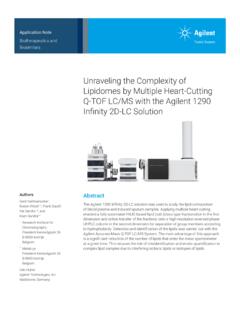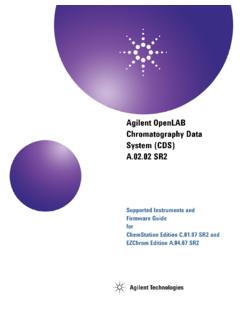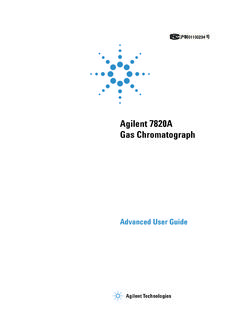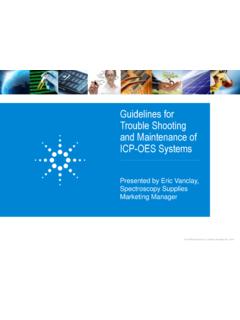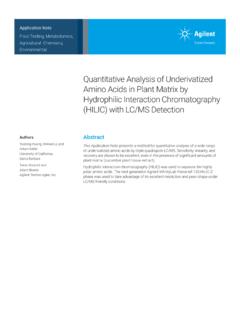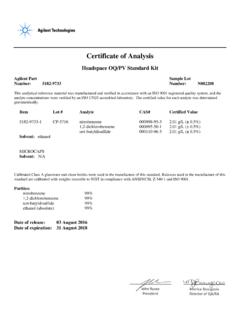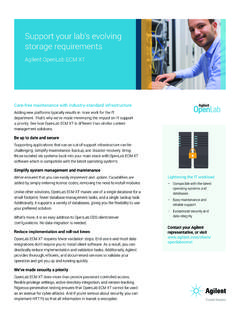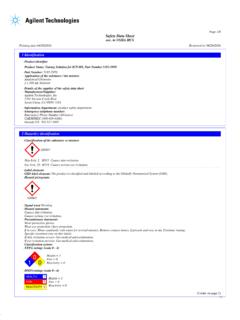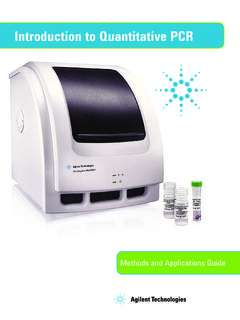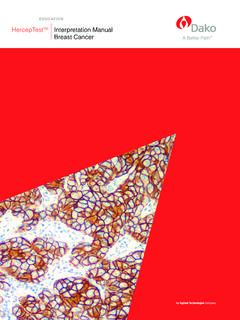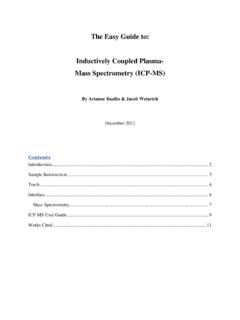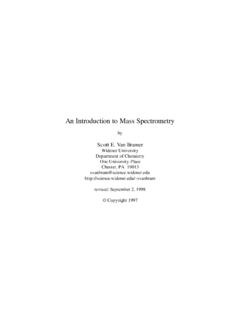Transcription of Teaching Tools: Fundamentals of Mass Spectrometry Theory
1 For Teaching Purpose Only5. April 20161 BUILDINGBETTER SCIENCEAGILENT AND YOUMass SpectrometryFundamentals TheoryFor Teaching Purpose Only5. April 20162 This slide set was created by Agilent for Teaching purposes you wish to use the pictures, sketches, or drawings for any other purpose, please contact Agilent Technologies is committed to the educational community and is willing to provide access to company-owned April 2016 For Teaching Purpose Only3 IntroductionMass Spectrometry (MS) is an analytical chemistry technique that helps identify the amount and type of chemicals present in a sample by measuring the mass -to-charge ratio and abundance of gas-phase mass spectrum (plural spectra) is a plot of the ion signal as a function of the mass -to-charge ratio.
2 From spectra, the mass of the molecular ion and fragments are used to determine the elemental composition or isotopic signature of a compound. This information is used to elucidate the chemical structures of molecules, such as pesticides or peptides. mass Spectrometry works by ionizing chemical compounds to generate charged molecules or molecule fragments and measuring their mass -to-charge : Wikipedia5. April 2016 For Teaching Purpose Only4 IntroductionNobel Prize Winning TechnologyJohn Fenn and Koichi Tanaka won the Nobel Prize in Chemistry in 2002 for the development of two soft ionization technologies: Electrospray technology, Dr.
3 Fenn Soft laser desorption, Dr. TanakaConcert Hall, Stockholm Sweden, Dec 2002Dr. Fenn getting his Nobel Prize from the King of Sweden5. April 2016 For Teaching Purpose Only5 Table of Contents (TOC)Introduction Basic Considerations Masses in mass Spectrometry Fundamental StepsHow It Works Ionization Electron Impact Chemical Ionization Sample Considerations (LC-MS) Electrospray Atmospheric Pressure Chemical Ionization Atmospheric Pressure Photo Ionization Multimode Ionization MALDI ICPHow It Works mass Analyzer Single quadrupole Triple quadrupole Ion Trap Time-of-FlightResults mass Spectrum Single Quad vs.
4 TOF Multiply Charged Ions and DeconvolutionFurther Information Agilent Academia Webpage Publications5. April 2016 For Teaching Purpose Only6 IntroductionBasic ConsiderationsElements can be uniquely identified by their mass . mass Spectrometry is an analytical method to measure molecular or atomic : Periodic table, poster SI-0186 Compounds, consisting of different elements, can bedistinguished by their mass :Glucose C6H12O6MW: 180,1559 g/molPenicillin C16H18N2O4 SMW: 334,39 g/mol5. April 2016 For Teaching Purpose Only7 IntroductionMasses in mass (H2O) + + ,ground-state,restmassoftheprincipal(mos tabundant) (moreappropriately,themeasuredaccuratema ss) , : WikipediaToC5.
5 April 2016 For Teaching Purpose Only8 IntroductionFundamental StepsTypicalMSprocedure: Sample(solid,liquid,gas)isionized Sample smoleculesmightbreakintochargedfragments duringionization Ionsareseparatedaccordingtotheirmass-to- chargeratio(m/z) Ionsaredetectedbyamechanismcapableofdete ctingchargedparticles( ) Resultsaredisplayedasspectraoftherelativ eabundanceasafunctionofm/zratio Identificationisdonebycorrelatingknownma ssestotheidentifiedmassesorthroughachara cteristicfragmentationpatternToCSample Ionization (positive or negative)Manipulate accordingto mass to charge ratio(or size to charge)
6 Detection + + ++++ + + + +++m/z Intensity 5. April 2016 For Teaching Purpose Only9 How It WorksIonizationBefore the sample can be mass analyzed, it must be ionized in the ion Sample Introduction: Electron Ionization (EI) Chemical Ionization (CI)Liquid Sample Introduction: Electrospray Ionization (ESI) Atmospheric Pressure Chemical Ionization (APCI) Atmospheric Pressure Photo Ionization (APPI) Multimode Ionization (MMI) Matrix Assisted Laser Desorption Ionization (MALDI) Inductively Coupled Plasma (ICP)ToC5. April 2016 For Teaching Purpose Only10 How It WorksIonizationPolarity of analytes determines the ionization WeightAnalyte Polarity100,000nonpolarvery polar10 APCIESIAPPIGCMSESIE lectrospray ionizationAPPIA tmospheric pressure photo ionizationAPCIA tmospheric pressure chemical ionizationGC/MSGas chromatography / mass spectrometryToC5.
7 April 2016 For Teaching Purpose Only11 How It WorksIonization Electron Impact (EI)Electron Impact (EI) is well established, and is the most common method of ionization in Gas chromatography (GC).The molecules exiting the gas chromatograph are bombarded by an electron beam (70 eV) which removes an electron from the molecule resulting in a charged + 1 electron CH3OH+ + 2e-EI typically produces single charged molecular ions and fragment ions (smaller parts of the original molecules) which are used for structure + CH2OH++ H or CH3OH+ CH3++ OH An electron or photomultiplier detects the separated ions.
8 The generated mass spectrum plots the signal intensity at a givenm/z ionFragment ionToC5. April 2016 For Teaching Purpose Only12 How It WorksIonization Electron Impact (EI)The GC/MS interface operates at high temperatures. The EI GC/MS Interface. Source: Agilent 7000 Series Triple Quad GC/MS Operation Manual(p 46)ToC5. April 2016 For Teaching Purpose Only13 How It WorksIonization Chemical Ionization (CI)EI is a direct energy transfer process with electron kinetic energy deposited directly into an analyte is an indirect process involving an intermediate chemical agent.
9 This is particularly true in positive chemical ionization (PCI). In PCI, the ion source is filled with a reagent gas which is ionized to create reagent ions which react with the frequently used reagent gases: methane, iso-butaneand applied reagent gas determines the ionization and fragmentationbehavior of the principal methane reactions are:CH4+ e- CH4+, CH3+, CH2+The reagent gas is ionized by electrons entering the ionization + CH4+ CH5+, CH3 CH2+ +CH4 C2H4+ + H2CH2+ +CH4 C2H3+ + H2+H CH3+ +CH4 C2H5+ + H2C2H3+ +CH4 C3H5+ + H2 ToCSee notes for details5.
10 April 2016 For Teaching Purpose Only14 How It WorksIonization Sample Considerations (LC/MS)ESIV olatility not requiredPreferred technique for thermally labile analytesIons formed in solutionCan form multiply charged ionsAPCISome volatility requiredAnalyte must be thermally stableIons formed in gas phaseForms singly charged ions onlyAPPISome volatility requiredAnalyte must be thermally stableIons formed in gas phaseForms singly charged ions onlyMany compounds will ionize well using all three sources. APCI / APPI can ionize molecules that are too non-polar for ESI to April 2016 For Teaching Purpose Only15 How It WorksIonization Sample Considerations (LC/MS)
